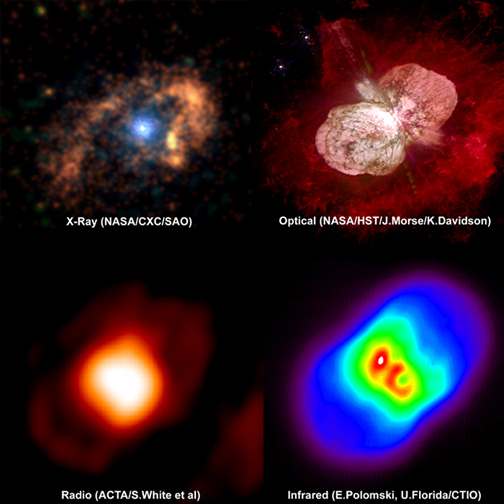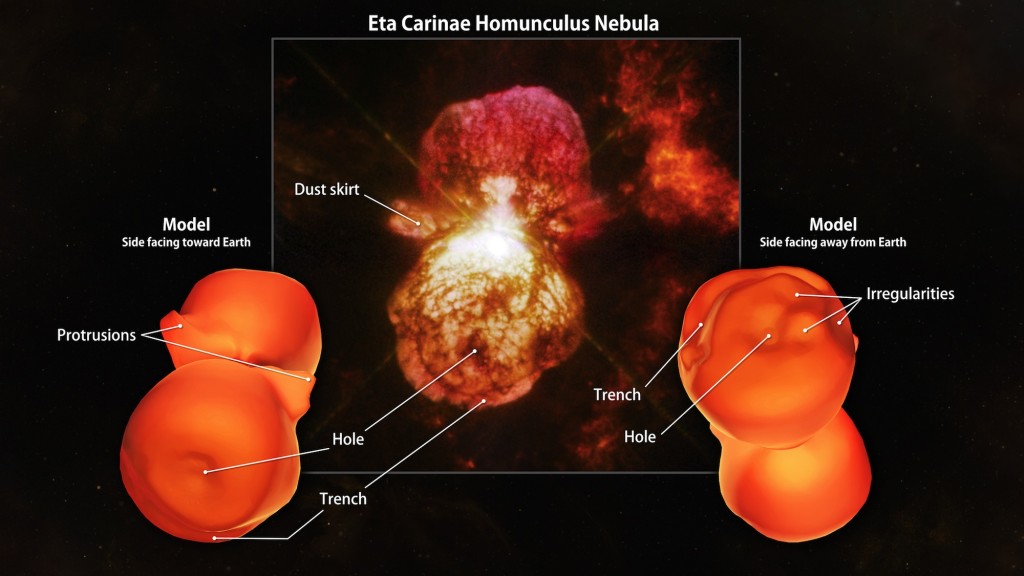Eating Eta Car
- By Maggie Masetti
- March 12, 2015
- Comments Off on Eating Eta Car
We recently posted about the gamma-ray novae cake made for a Science as Food competition at a Poster Party here at Goddard. Dr. Barb Mattson also participated in this contest and we caught up with her to find out more about her Eta Carina cake.
NASA Blueshift: Can you introduce yourself?
Barb Mattson: I’m an astronomer-turned-educator who leads the education activities in the Astrophysics Science Division – in particular leading the activities for the Physics of the Cosmos and Cosmic Origins programs. These are NASA programs that focus on the beginning and history of the Universe and how the Universe works. Our group creates curriculum support materials for classrooms and informal education settings.
NASA Blueshift: What was the event for which you made a cake?
Barb Mattson: This was for the Science as Food competition at the Poster Party Blow Out held by our directorate. This event is designed to allow scientists from all our science divisions to get together and share the science they’ve done throughout the year. They dust off posters they’ve presented at meetings throughout the year and share them with other Goddard scientists. This allows them to reuse their posters and provides the opportunity to share them with folks outside their expertise, sometimes fostering new collaborations.
NASA Blueshift: Tell us about your cake. What inspired you to choose that astronomical object to represent?
Barb Mattson: Fairly simply, my boss asked if I might be able to do something for his research group. I could have said no, but I enjoy playing with my food.
The object is the Homonculus Nebula, a cloud of gas and dust that houses a binary system called Eta Carinae, or Eta Car for short. This has been a big year for those studying Eta Car. The research group released a 3D model of the nebula in July, which they were able to create using near-infrared, visible and ultraviolet observations of swaths across the nebula.
The stars in the Eta Car system come to their closest approach [to each other] about every 5.5 years, and this happened again last August. During the time leading up to periastron, the X-ray emission from Eta Car changes dramatically – the system experiences X-ray flares, then the X-ray emission disappears, and eventually recovers. The research group was particularly interested in observing Eta Car during this period to test models they had developed to explain the behavior. They presented some results last month at the American Astronomical Society meeting.
NASA Blueshift: What is significant about the Homonculus?
Barb Mattson: The Homonculus Nebula is believed to have been ejected as a outburst from Eta Carinae. Astronomers observed an eruption in the 1840s, which is at least partly responsible for the nebula that we see today.
NASA Blueshift: What were the important features of the Homonculus that you wanted to model?
Barb Mattson: Since the team had recently made a 3D model of the nebula, I wanted to represent as much of that as I could with cake (and not being a professional cake decorator!). I wanted to make sure that I had the general shapes of the two lobes correct. I also wanted to represent the two “wings” of the nebula (labeled as “protrusions” in the image of the 3D model). I also wanted to show some of the features on the far side of the nebula, like the trench and hole marked in the image below.
I frosted one lobe in red and the other in blue – this was to represent that one lobe is moving away from us (redshifted) and the other moving toward us (blueshifted).
NASA Blueshift: How well did you feel you were able to represent the Homonculus with cake? Did it have shortcomings as a medium?
Barb Mattson: I was able to get the overall shape and some of the bigger features pretty well represented in the cake. However, I’m just not skilled enough as a carver to show some of the finer details. The frosting was also a bit of a hindrance, since it filled in some of the carving that I did on the far side of the nebula.
NASA Blueshift: Is this your first foray into astronomical baked goods?
Barb Mattson: This is my first foray into *astronomical* baking; however I have been known to enter a gingerbread decorating contest or two. (Or five.)







